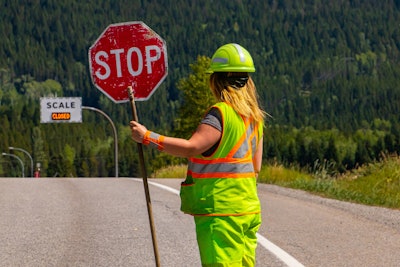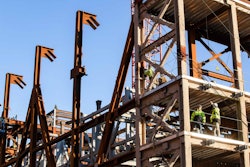
The roads we drive daily are busy, and while basic traffic rules are not difficult to understand, statistics show that at least 50 million people are hurt or disabled in traffic crashes yearly. For people under age 54, roadway collisions are also the leading cause of death in the U.S. Here’s the kicker: more than 50% of all crashes that cause injuries or fatalities happen near or at intersections. This week is Stop on Red Week, an initiative created to highlight the risks of reckless driving. In observance, let’s acknowledge these realities and work together to understand the actions we can take to change course and reduce the number of vehicle crashes.
Distracted driving is reckless driving
Within the context of construction fleets, there are many reasons that crashes happen. The one that occurs the most is distracted driving, claiming the lives of 3,142 people and injuring more than 420,000 drivers in 2020 alone, according to the National Highway Traffic Safety Administration (NHTSA). Even at just 55 mph, a single peek at a cellphone to read or send a text message can divert a driver's focus from the road for five seconds, allowing their car to travel the length of a football field.
Picture this: a construction worker headed to the job site stops at a red light and checks his or her phone, and when the light turns green, someone behind the driver honks their horn, causing the distracted driver to punch the gas without looking both ways. Or perhaps the driver behind the worker becomes impatient and swerves around them. Either way, the risk of a collision is increased due to cell phone use at the red light.
Another scenario pertaining to construction fleets is the risk of drivers rushing to the job site. What’s worse – an employee arriving a few minutes late or blowing through high-traffic intersections to avoid employer penalties? Now imagine a worker rushing to the site, texting their boss they will be late, and experiencing a collision. While the worker made the wrong decision, one could argue their employer did not do everything in their power to ensure this wouldn’t happen.
The consequences of reckless driving are more prevalent for employers that require workers spend time on the road while on the clock. Employers paid about $18.8 billion in 2018 for crashes caused by distracted driving, according to the Network of Employers for Traffic Safety. Cell phones use behind the wheel has forced fleet managers to monitor driver behavior and offer opportunities to learn and improve.
Acknowledging Stop on Red Week
Stop on Red Week is the perfect time to reiterate the importance of all the traffic rules in place. Created by the Federal Highway Administration (FHA), the initiative was created to educate drivers about the seriousness of traffic collisions and how basic safety at red lights and stop signs can save lives by reducing crashes.
Here are a few reasons why Stop on Red Week is so important:
- Traffic rules are reintroduced. People in a rush might not take traffic signals seriously, which can lead to road accidents near busy intersections. Stop on Red Week highlights the importance of adhering to traffic signals to avoid any damage or injuries caused when rules are ignored.
- The importance of traffic signals is reiterated. Most drivers know basic traffic rules, but it’s easy to forget how important they are and why it’s critical they are adhered to.
- It encourages drivers to avoid reckless driving. Somebody running late to work can quickly get frustrated when they are unable to make a left turn, or they hit a sea of red lights. The initiative encourages the public to stop and think about how dangerous the roads would be if drivers, many of which are distracted, barreled through intersections.
Fleet liabilities
Distracted driving be dangerous, but it can also be costly to any fleet operation in the following ways:
- Costly repairs to vehicles or the replacement of a vehicle. This also means a fleet operation will have one fewer vehicle on the road in the meantime.
- Lawsuits are always expensive and time-consuming.
- Medical expenses and worker compensation claims.
- Raised insurance costs, brought on by even the most minor accidents.
- The risk of a damaged reputation when a fleet’s driver causes injury or fatality causes current and potential customers to think a company’s drivers don’t pay attention to safety.
Safeguard fleets with technology
There are many solutions available for fleets to manage their drivers and ensure they are driving responsibly. The primary course of action for contractors and construction crew managers to ensure safe driving is to implement smart dash cameras. With video capture, cameras can detect real-time incidents, determine who is at fault, and execute intelligent automated reporting for enhanced visibility across a dispersed fleet. Smart dash cams can detect distracted driving behavior, hard acceleration, speeding violations, driver drowsiness, seatbelt non-compliance, stop sign and traffic sign violations, and the driver’s following distance –to name a few metrics.
Not only can dash cameras save fleet managers the effort of reviewing, evaluating, and storing footage by doing all the heavy lifting, but it also sends alerts and videos when drivers exceed the thresholds set for various behavior. Every second of driving is analyzed for driver safety, and many smart cams use artificial intelligence (AI) to recognize adverse driving behaviors without human intervention. With this, drivers can receive coaching and in-cab alerts in real-time – offering the opportunity to improve.
Proactively boosting safety
Regardless of the reason, proactive recognition and correction of dangerous behavior protect drivers and others from harm and, at the very least, can help avoid costly traffic violations. Dash cams detect driving behaviors and inform driver coaching and training programs that will boost overall safety. At the end of the day, implementing smart dash cameras will create an environment where everyone on the road is safer, and costs associated with distracted driving are reduced.
Use #StopOnRedWeek across Twitter, LinkedIn, and other social media to carry on the conversation.



















